In the rugged and remote district of Mae Sariang, along the Thai-Myanmar border, the fight against malaria—a potentially life-threatening disease transmitted by mosquitoes—presents formidable challenges. These include geographic isolation, harsh monsoons, and frequent cross-border movements, compounded by high population mobility and limited healthcare infrastructure. Nevertheless, the Vector Borne Disease Unit (VBDU) and the Ministry of Public Health Thailand are at the forefront of the Mekong Malaria Elimination (MME) initiative, demonstrating the steadfast commitment of local health workers and the community to overcome these hurdles.
The World Health Organization (WHO) highlights the need for urgent adjustments in malaria strategies to prevent avoidable deaths and meet elimination targets. Persistent health inequities hamper efforts, particularly in regions bearing the heaviest disease burden, and impede progress towards eradicating malaria. These challenges are compounded by drug and insecticide resistance, fragile health systems, and inadequate funding. Additionally, climate change and humanitarian crises such as natural disasters and conflicts exacerbate vulnerabilities, hindering effective disease control. WHO emphasizes the importance of universal health coverage and primary health care to improve access to quality services for all at-risk populations and boost community participation. Moreover, gender-transformative programs are vital for addressing social norms, roles, and inequalities that affect health outcomes. These comprehensive efforts align with the goals of local initiatives like those in Mae Sariang, where community engagement and tailored healthcare innovations are key to overcoming the complex landscape of malaria elimination.
Darunee Khongkarat: A Woman's Three-Decade Fight Against Malaria in Mae Sariang
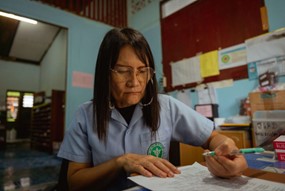
Darunee Khongkarat, a microscopy technician fills out a surveillance form on a malaria patient. © WHO 2023
This story unfolds through the lens of Darunee Khongkarat, or "P'Odd," a dedicated microscopy technician who has been combating malaria in Thailand for over three decades. Working at a malaria clinic in the rugged district of Mae Sariang, Darunee has employed cost-effective solutions to overcome significant challenges, ranging from initial gender biases to the logistical difficulties of reaching remote areas. Despite these obstacles, she has witnessed significant advancements towards greater social acceptance and improved access to healthcare, particularly for ethnic communities and migrants from Myanmar. Yet, the journey to these communities remains perilous, especially during the monsoon season when landslides and flooding are common. Darunee's commitment to using low-cost healthcare solutions and her deep engagement with the community are crucial in navigating the complex landscape of malaria elimination in this frontier region.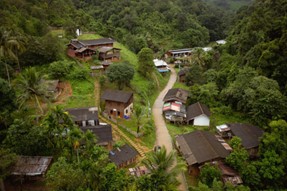
An aerial view of Huai Hom village, Mae Sariang. © WHO 2023
Darunee says in the 1990s when she first started her career in malaria, health centers were reluctant to hire women. The job often involved traveling to remote areas and many did not believe this an appropriate activity for a young woman. While accessing far-flung villages remains a challenge, in those days, traveling to remote communities sometimes meant hiking up mountains carrying heavy equipment, food, and medication. Today, the majority of villages can be accessed by road, but landslides and flooding during the monsoon season can still make travel hazardous or difficult.
“Things are more socially acceptable now than they were back then,” she says. “People would say, ‘let’s see how long you last!’ expecting me to quit my job within the first few years. Over time, colleagues came and went, but I remained. That’s how I proved myself, by continuing to stick it out! In the end, I was the last woman standing.”
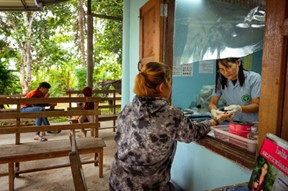
Darunee collects blood from a malaria patient at a malaria clinic in Mae Sariang. © WHO 2023
Darunee says there are distinct advantages to being a woman health worker. Men may feel uncomfortable asking women patients relevant but personal questions, such as whether they are pregnant. Women patients in turn may feel uncomfortable discussing personal information with male health workers they don’t know.
A key part of malaria elimination is raising public awareness. Every Saturday between 1-2pm, Darunee hosts a local public radio show to speak about malaria elimination and prevention efforts in Mae Sariang. With unreliable and expensive internet access in the mountains, radio becomes a vital tool for communication. Darunee's messages are particularly relatable to women, who often are primary caregivers in their households, and to children at school, helping her build rapport within the community.
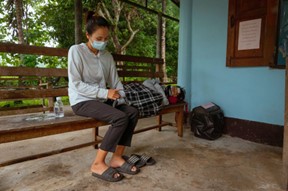
A Karen mother seeks help at a local health clinic for her child, who has a high fever due to malaria. © WHO 2023
In rural villages where formal education and literacy rates are often low, identifying and treating malaria can be particularly challenging. Many villagers are hesitant to travel for testing and treatment due to financial constraints and the time required to reach distant hospitals. "It's difficult to tackle malaria without taking a whole-of-community approach that ensures no one is left behind," says Darunee.
Chaloern Samajit Suaingam's Journey: Overcoming Obstacles in Malaria Elimination in Mae Sariang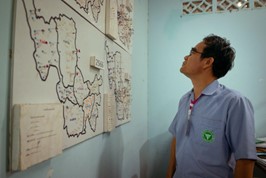
At the Vector Borne Disease Unit (VBDU), the Chief Public Health Officer analyzes a large map of Mae Sariang district, using pins to strategically track malaria cases. © WHO 2023
The Mekong Malaria Elimination programme, aiming for malaria eradication across the subregion by 2030, faces challenges reaching remote ethnic communities, especially those nestled in the mountains along the Thai- Myanmar border, where access to healthcare is complicated by seasonal landslides, with some villages only accessible by boat. Two years ago, while traveling up the Yuam river to establish a local health center, Chaloern Samajit Suaingam, Chief Public Health Officer of VBDU Mae Sariang, experienced these challenges firsthand when his boat ran out of fuel and capsized after colliding with another vessel due to a strong current. Rescued by another boat after losing personal belongings, including his phone and watch, Chaloern remains determined to overcome such difficulties and continue being a strong role model as a single father to his children.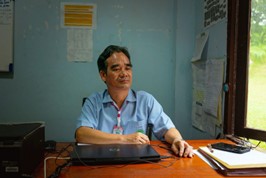
A portrait of the Chief of VBDU Mae Sariang , who is also a member of the Karen ethnic community. © WHO 2023
Chaloern, is a member of the Karen ethnic community which helps him to communicate with villagers in the area, who often only speak Karen. Being Karen helps him to see eye-to-eye with other community members, and more effectively encourages them to sleep under long-lasting insecticidal nets. “In the villages, the culture is different than in Mae Sariang or other more populous towns,” says Chaloern. “Sometimes, I have to tell them that not completing their malaria treatment is bad karma. Locals need to understand that the finishing and following up with the treatment is supporting public health to make sure we are fighting malaria the right way for the good of everyone.”
Dr. Aungkana Saejeng: Innovating Malaria Diagnostics for Community Enhancement
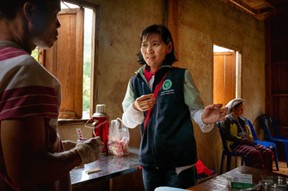
Dr Aungkana advises a local community health worker supporting ethnic community members in Huai Hom village. © WHO 2023
Dr. Aungkana Saejeng is a medical technologist with the Office of Disease Prevention and Control 1, Chiang Mai, and the inventor of the ‘webscope’ which is now commonly used to help streamline the malaria diagnosis process. It was after her PhD thesis at university that Dr Saejeng invented a low-cost microscope camera which can be linked to the internet. With this camera, microscopists in remote areas can share pictures of blood slides taken to diagnose malaria with Dr Seajeng’s lab for cross-checking and validation. The method has reduced the time needed for cross checking from around 21 days to only 10 minutes. She continues to work closely with microscopy technicians like Darunee and advises them on how to increase the quality and efficiency of their work.
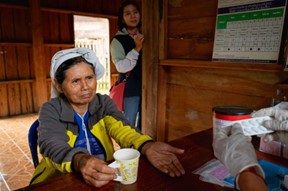
Sepor Sangiamjai waits to be given malaria medication. © WHO 2023
Parallel to this technological advancement is the personal story of Sepor Sangiamjai, a 65-year-old rice farmer from the village of Huai Hom, who recently contracted malaria for the first time. Undergoing treatment as part of the 28-day malaria surveillance process, Sepor's experience underscores the importance of local health centers. "Since the health center opened last year, no one in our village has died of malaria," she shares, highlighting the center's life-saving impact. "It gives us peace of mind," she adds, emphasizing the value of accessible healthcare facilities in rural areas like hers, contrasting with neighbouring villages that lack such critical infrastructure.
The collective efforts of the Vector Borne Disease Unit, laboratory innovations, and strong local health systems exemplify the critical steps toward malaria eradication in Mae Sariang. The personal accounts of Darunee Khongkarat, Chaloern Samajit Suaingam, and the technological advancements introduced by Dr. Aungkana Saejeng, along with community stories like Sepor Sangiamjai's, underscore the vital role of community involvement in managing and eliminating malaria. These joint efforts offer a model for healthcare in other remote and challenging environments.
